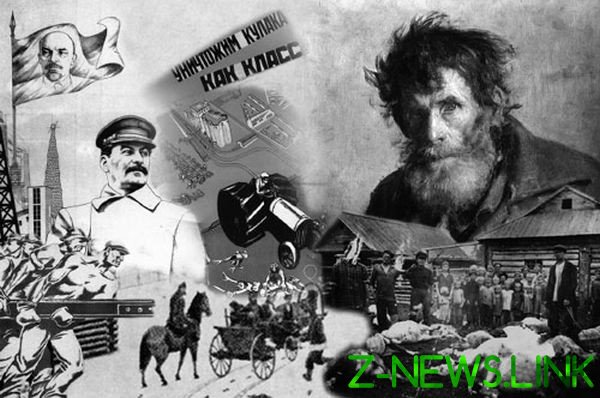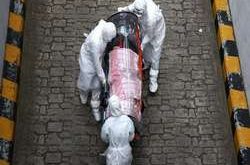
In the mid-1920s, when Stalin made the first steps to consolidate power, neither the Union nor Russia has ever had a well-established modern system of demographic statistics. However, at this time already gathered and processed, albeit not universally, fairly rich information about all of the main demographic processes, in 1926, conducted one of the best Soviet census of the population, all available data have been widely published and carefully analyzed, developed demographic forecasts, has been on the rise of demographic research. Next to the demographers, has acquired fame even before the revolution (V. Mikhaylovskiy, P. Kurkin, S. Novosel’skiy), worked more, young M. Ptuha, V. paevsky, Korchak, Y. He, S. Tomilin, A. Khomenko, and others. In the early 30-ies in the country, there were two demographic research Institute in Kiev and Leningrad.
In 1953, after the death of the leader, the information field of demographic statistics and research the field of demography was a scorched desert.
Already in the early 30-ies was in full swing classification demographic information, gradually crossing to its falsification. In particular, it was declared “subversive” census of 1937, and in 1939 there was a new census, the results of which were more satisfied with the leadership of the country. Has been eliminated both demographic Institute in Leningrad in 1934, Kyiv – in 1939. Almost disappeared the demographic of the publication. The brutal repression collapsed on themselves demographers.
V. paevskiy, is a leading figure of the Leningrad demographic Institute, died in 1934 at the age of 41 of a heart attack a few hours after the decision on the closure of the Institute. In the late 30-ies in a short time was arrested and shot three successive head of the state statistical service V. Osinsky, Ivan Kraval, I. Vermenizi. The shooting ended the life of the head of the censuses of 1926 and 1937 O. Kvitkina, Ukrainian demographer A. Khomenko. In the camp killed another leader of the census of 1937 L. Pangender. Through the arrest, prisons and camps were Ptukha M., Korchak, Y. He, Smulevich, M. Tracewski, A. Mark, M. Kurman…
Withholding information on the demographic processes in the USSR has reached an incredible limit. Even the total population of the country was not known. Only in 1959 – 6 years after Stalin’s death and 20 years after the census – population 1939 – there was a new census, statistics through which felt under his feet a kind of sustainable soil and were able to calculate the required demographics. The results of the 1959 census and their comparison with the results of the 1926 census gives an indication of the demographic results of Stalin’s rule. What kind of results?
Fertility: great breakthrough
In the early twentieth century, Russia was a country with a very high birth rate. During the First world war and the civil war, the birth rate for obvious reasons, has declined, but by the middle of 1920-ies the life of the population, then, for the most part, peasant, Russia, Ukraine, and other regions of the USSR – normal, and recovered the pre-war high fertility. But this post-war rise did not last long, by the end of 1920-ies was very strong decline that accelerated sharply after 1929 – Stalin “year of great change”.
Reaching a maximum depth of fall of 1934, after the terrible famine in the years 1935-1937 the birth rate in Russia again increased somewhat, but never returned to the level that existed before 1933. In 1935, when Stalin uttered his famous words that “life has become merrier” and “more birth rates, and net growth turns out much more,” the total fertility rate in Russia was almost 40% lower than in 1927. As for natural increase, it was almost twice lower than in 1927 (11‰ to 21‰).
Fertility decline in the country, embarked on the path of industrialization and urbanization, the natural process. What is striking in Stalin’s Soviet Union, is the tremendous speed of fertility decline. In order for the demographic behavior of entire generations almost instantly rebuilt, the people had to experience an incredible shock. Such a shock and became for the majority of the population of the USSR, the events of the late 1920’s-early 1930-ies: forced collectivization, dispossession and hunger. In a sense, the shock was much stronger than the shock of the First world and civil wars, revolution and post-revolutionary chaos. After the population returned quickly to the old standards of the demographic and family behaviour, whereas a shock early 30s led to irreversible changes.

Fig. 1. Total fertility rate
in Russia and Ukraine
Frightened by this unexpected consequence of their economic and social policies, Stalin tried to extend the mechanism of repression, and in this area of life of Soviet citizens. A few months after he with great fanfare, but without any reason stated that the population of the Soviet Union “began to multiply much faster than in the old days”, the country was denied an abortion.
Sources: Russia 1927 – 1940; 1950 – 1958 – rating Andreeva and co-authors; Ukraine in 1925 – 1929 – calculation after mV ptukha; Russia 2 – (1950 – 1958) and the Ukraine for the same years – evaluation A. Blum.
The years immediately following the prohibition of abortion, marked some rise in the birth rate, but it was small and short-lived. Prohibition of abortion did not bring the expected effect, and then the war caused a sharp decline in new births, and Stalin decided to tighten up the nuts. At the end of the war, in 1944, a decree was issued that will increase the status of a registered marriage and complicate its termination. On the other hand, at the same time an attempt was made to raise the prestige of motherhood by introducing state awards to mothers of large families and provide them with certain benefits.
Judging by the fact that the measures failed to halt the fertility decline, increased state involvement in family Affairs was ineffective. Moreover, countries emerging from totalitarian regimes tried to influence family and demographic behavior of people (Germany, Italy, Spain, Russia, etc.), demonstrating in our time the deep drop in the birth rate. Perhaps this is due to the fact that state intervention in any form – and using the carrot and using the stick – does not increase the forces of self-organization of the family and reduces them.
From 1925 to 2000, the total fertility rate in Russia declined by 5.59 child per woman (from 6.80 to 1.21) (Fig.2.). Of them of 3.97 of the child, or 71% of the total reduction accounts for the years 1925-1955 – “the Stalin era”.
Mortality: no fracture
According to official estimates, the overall mortality rate for the USSR as a whole amounted in 1913 to 29.1‰, in 1926 to 20.3‰, and by the 1930s, according to Stalin’s statement about reduction of mortality by 36%, fell to 18-19‰. For even greater success was reported 5 years after the end of the terrible famine. In 1935, the mortality rate was 56% from level of 19131, a decrease of 44%, or to about 16‰.

1897-2002 years
It would take many years to get the researchers got to the secret archives and on the basis of all available data concluded that the total mortality of the Soviet population in 1930 was no 18-19, and 27‰; and in 1935, its value was, respectively, 16, and about 21‰. Like in the Soviet Union, was then the General mortality rate in Russia (27,3‰ в1930 and 23.6 in 1935) (Fig. 3).

in the Soviet Union. 1890-1960.*
* Large dashed line – trend line of the years 1890-1913
Sources: the population of the USSR 1987. The statistical compilation. Moscow, 1988, p. 127; Rashin, A. G. Population of Russia for 100 years. Moscow, 1956, p. 156; E. Andreev, L. Darskii, Kharkov T. the population of the Soviet Union. 1922-1991. M., 1993, p. 120; E. Andreev, L. Darskii, Kharkov T. Demographic history of Russia: 1927-1959. M., 1998, p. 164.
Now look, as was the case with infant mortality, about which Stalin, speaking in 1930, the XVI Congress of the CPSU(b), said that it was reduced by 42.5%. If it was in fact, the infant mortality rate for 1930 would have to drop to 155 per 1,000 live births, he was, according to later estimates of demographers, 196 to 10002, i.e. 27% less than in 1913 (then in the first year of life in Russia died 269 out of every thousand born). In Russia at this time the indicator was above all-Union and was 227 per 1000.
According to calculations it appears that the mortality – General and infant in 1930 was actually lower than in 1913. Why Stalin did not satisfy the true rating of this success, albeit more modest? The answer is related to two circumstances.
First, the mortality was reduced already before the revolution, so its a moderate decrease could not be attributed to the merits of the Soviet regime. Moreover, the mortality rate in the 1930-ies was considerably higher than would be expected while maintaining the pre-revolutionary tendencies – all of them are above the trend line 1890-1913 (see Fig. 3).
Second, the indicators in 1930 was although better than before the war, but worse than achieved in the 1927-1928., prior to the implementation of Stalin’s chief of projects.
Thus, already in 1930, laid the foundations of the false mythology of the extraordinary successes of the Soviet regime in the protection of public health, which seems to have survived to the present day.
Meanwhile, the dynamics of the expected (average) life expectancy indicates the almost complete lack of progress “in the years of the Stalinist five-year plans”.

and at the age of 30 years. Russia, 1897-2001 years
As shown by E. Andreev (Fig. 4) even if we take only the most favorable, “crisis-free” years of the interwar period, the life expectancy of women rose significantly above the pre-revolutionary level (approximately 45 years), but men have no growth compared to the last pre-war years almost was not. The situation changed only after the war, and by 1953, the life expectancy of both men and women exceeded the best pre-war figures of approximately 20 years. However, this success was achieved mainly by reducing mortality in childhood, which in turn was due to the advent and mass introduction of antibiotics. But the increase in the life expectancy of the adult population was much more modest and short-lived, he very soon ceased, and men even later gave way to reduced life expectancy.
A demographic disaster as the norm
Even those modest successes, which actually took place, applies only to “normal” years, which in Stalin’s time, constantly punctuated by disastrous years.
Stalin’s rule was marked by the greatest country in the history of military losses, primarily in the Second world war. Stalin did everything to hide their true scale.
He called the losses – “about seven million people” – was made public in February 1946, although, according to military historians, “at that time the leadership of the country was known for more accurate data – 15 million dead”3. But subsequently these data were understated, and they have gone to review. According to the latest official Soviet estimate, given by Mikhail Gorbachev in may 1990, the war claimed nearly 27 million lives the Soviet people. For the USSR, which had by the beginning of the war, about 195 million people, this meant a loss of 14% of the prewar population.
Stalin’s assessment of the losses of the USSR in the Second world war has been revised, but created by Stalin and his surrounding mythology of the inevitability of these losses still persisted. And now it is considered good form to remember the heroism of the war years and to gloss over the question of the responsibility of the Generalissimo for the lack of preparedness for war, the incompetence of the military operations in the first stages of it, for the “costly” method of getting the victory, suffering great casualties.
Against the backdrop of huge losses in the Second world war 127 thousand deadweight loss (Yes, 265 thousand wounded, contused, burnt, frostbitten, etc.) for three and a half months of the war with Finland (December 1939 – March 1940) seem almost a trifle. But compare this one too lying on the conscience of Stalin trifle, say, losses in the Second world war countries such as USA (300-400 thousand according to different estimates) or England (350-450 thousand).
The second group catastrophic demographic losses of the Stalinist era connected with hunger. According to relatively recent estimates, the Soviet Union, they made 7-7. 5 million, in Russia – 2.2 million people. But there was another famine after the war. It was the result of the drought of 1946, began in December and continued until the harvest of 1947. According to some estimates, the loss of life as a result of the famine in the USSR amounted to about 1 million people.
The third source of catastrophic demographic losses, which became almost the trademark of the entire Stalin era political repression.
The expense of the victims of repression, including the resulting number of premature deaths in the millions, but the exact number is still not known. A huge number of people were simply shot. One day, according to recent official information, “in 1930-1953 years on charges of counterrevolutionary and state crimes in the judicial and all kinds of non-judicial bodies of the sentences and ordinances against 3778234 people, including 786098 shot”4. It is not excluded that this information understates the number of people shot.
“In addition, and this we know for sure, many perished in the camps and prisons without being sentenced by a “court” to death”5. The Gulag flourished in the 1930-ies, was enlarged during the war, has not disappeared after it. Moreover, at the end of the war, mass repression increased again and did not stop until 1953. The total number of prisoners in prisons, colonies and camps in the early 1950-ies close to 2.8 million people.
By this time almost disappeared, the first wave of mass Stalinist repression – the “kulak exile.” A new form of repression were deported peoples. The total number of Soviet citizens who were deported in the USSR in the war and postwar years, amounted to approximately 2.75 million people.
It is known that the mortality rate in the camps, during deportations, settlements of the deportees was horrifically high, so population losses here were much larger than from direct executions. Assessment D. volkogonova, as a result of Stalinist repression from 1929 to 1953 in the USSR killed 21.5 million people. But while one can hardly consider this estimate to be exhaustive or rigorously proven.
The years of wars, of famine, and the rise of mass repressions literally “flashed” “the Stalin era”. Since 1929, there was more than “normal” years. Accordingly, it is not easy to separate the “normal” mortality, arguing about which one can speak about the success of health care, sanitary hygiene, medicine, etc., from the catastrophic death people dropped in almost primitive conditions. All this made itself felt later, when Stalin was no longer alive, was not the obvious demographic disaster, and the Soviet Union and its core – Russia – long stalled on the way in which other countries with the triumph moving to higher life expectancy.
Demographic ruin
Falsification of demographic data – not so easy. You can call any fertility or mortality and force them to believe, but sooner or later they are subject to objective verification, because they determine the population and, therefore, the number of workers and consumers, soldiers and constituents, school children and pensioners.
In Stalin’s Soviet Union it was possible. The population of the country has turned into a carefully guarded state secret because its publication would make immediately obvious the perennial lies of the government and of Stalin personally.
Before over population was covered by a veil of secrecy, it has been repeatedly falsified. In 1934 at the XVII Congress of the CPSU(b) Stalin called the fake number of the Soviet population of 168 million people. Proceeding from it, the Soviet experts had expected the census of 1937 will lock in the country 170-172 million. But it was considered just 162 млн6. Not surprisingly, the census of 1937 was declared subversive, and in 1939 there was a new census, and every effort was made at this time, the census confirmed the false statements of the government. The census was conducted in January 1939 and in March, even before receiving its final outcome, speaking at the XVIII Congress of the CPSU(b) Stalin said that the country’s population of 170 million people. Naturally, subsequently published results could not be less than that declared by the leader figures.
Subsequent historical events – including in 1939 in the USSR of the Baltic States, Western Ukraine and Western Belarus, and then the war, the gtr moved the question on the demographic results of the Soviet thirties by the wayside, and after the war Stalin, apparently, given the not very successful experience of their pre-war fraud, decided to stop publishing data about the population of the USSR.
Even in the mid-1950s years, numerous researchers have still tried to at least roughly estimate the number of inhabitants of one of the largest countries in the world. French demographer sauvy A. cited then the summary of these ratings from 213 to 220 million people in mid-1955. When, three years after Stalin’s death, was first published the official figure, it was significantly below all of the available estimates: of 200.2 million in April 1956 года7.
Assessment of demographic losses of the USSR national experts, received access to archival materials have become possible much later. According to these estimates, the number of excess deaths in 1927 – 1940 amounted to 7 million, in 1941-1945 – 26-27 миллионов8. But there were also direct losses from the famine of 1946-1947 (approximately 1 million people) and victims of the post-war Gulag. So the total direct losses of the Stalinist Soviet Union is not less than 35 million people, and, most likely, they are above. And besides, you should consider a significant reduction in the replenishment of the population at the expense of children not born prematurely dead.

Fig. 5. The growth of Russia’s population – actual and
in the absence of demographic catastrophes
If we imagine that the two major demographic catastrophes of the Stalin period – the famine of the early 30-ies and the Second world war, as well as other upgrades mortality, reduced growth rate of the population of Russia was not, then, since 1926, the population at the expense of the balance of births and deaths would rise as shown in Fig. 5.
In 1926, when Stalin first came into power, Russia’s population was 93 million.
Until 1941, the country had not known a major war, and its population could grow approximately 121 million people. In fact in 1941 it was 9 million less than the total 112 million. Only in 1935 was restored a number of 1930 – after the demographic collapse of the time of collectivization and dispossession. I was a terrible failure – the military. The prewar population of Russia was restored only in 1956 – 11 years after the end of the war and three years after Stalin’s death.
Thus, 15 years – more than half of the period of Stalin’s rule, Russia has been in terms of demographic losses can not be replenished, even compared with the time already reached level, i.e. being demographically pushed back.
By the time of Stalin’s death, Russia’s population stood at 107 million. If the excess losses in years of his reign were not, the Russians in 1953 could be 40 million more.
Anatoly VISHNEVSKY
LITERATURE.
1. Socialist construction in the USSR. Statistical Yearbook. M., 1936, p. 545.
2. Andreev E., Darsky L., Kharkov T. the population of the Soviet Union, p. 135.
3. Great Patriotic war of 1941 – 1945. Military essays. KN.4. The people and the war. M., 1999, p. 282.
4. The Committee of state security of the USSR. “Izvestiya” on 13 February 1990.
5. D. A. Volkogonov, Triumph and tragedy. October. M., 1988, p. 129.
6. Andreev E., Darsky L., Kharkov T. the population of the Soviet Union, p.25.
7. A. Sauvy. La population de l’union Sovietique. Situation, croissance et problemes actuels. Population, 1956, n 3, p. 464.
8. Andreev E., Darsky L., Kharkov T. the population of the Soviet Union, pp. 60, 77.
© 2019, paradox. All rights reserved.





